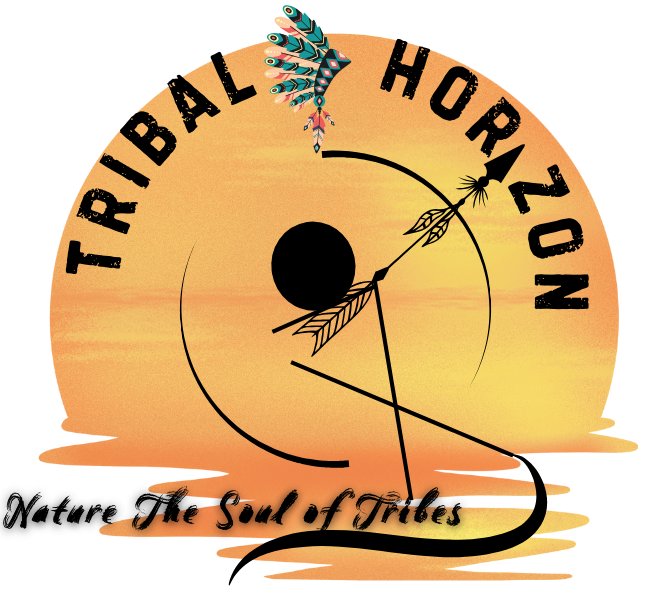Karma Festival is a lively tribal festival in India, celebrated mainly in Jharkhand, Chhattisgarh, Odisha, Bihar, and Madhya Pradesh. This festival honours Karma, the god who protects crops and brings prosperity. It is a time for devotion, dance, and community togetherness. Tribes recognise the god of crops in different ways, but they celebrate Karma festival to thank Karam. People gather around the sacred Karam tree, sing folk songs, and perform traditional dances. These actions show gratitude for nature, fertility, and their ancestors. Karma Utsav is a cherished cultural celebration.
History and Origin of Karma Festival
The Karma festival has strong roots in the lives of tribal communities in India. It is especially significant in Jharkhand, Chhattisgarh, Odisha, Bihar, Madhya Pradesh, and West Bengal. People worship Karam, the deity who represents strength, fertility, and prosperity. Karam is believed to protect crops, livestock, and families. Folklore suggests that neglecting the Karam tree brings misfortune to the villagers.
This festival is for both boys and girls. Unmarried girls and boys celebrate it together. Once a boy gets married, he no longer participates in the celebration. Boys typically celebrate the festival only until they get married. Girls celebrate during their first year of marriage and continue to celebrate it afterwards.
This belief leads them to honour the tree with folk songs, religious rituals, and communal feasts called Bhandara. Over time, the Karma festival has come to symbolise harmony between tribal communities and the natural world. It originates from their agrarian lifestyle, where community gatherings, storytelling, and dancing around the Karam tree help strengthen social bonds. This ancient festival shows the deep respect tribal people have for their environment and ancestors.
Karma Festival: Woven into Tribal Myths and Living Oral Traditions
Karma Utsav is more than just rituals and celebrations; it is also connected to oral traditions and stories from tribal life. For centuries, elders have shared these stories around the fire, teaching each new generation about the importance of karma (action), dharma (duty), and respect for nature. The well-known legends linked to this festival still shape its meaning today. We will explore these legends and share them with you.
Lessons from Tribal Myths of Karma Festival
The legend of Karma Utsav is about two couples, Birsa and Nanaki. They were farmers who lived happily but were sad because they had no children. One day, while working in their field, Nanaki felt tired and rested under a nearby karam tree. She fell asleep and dreamed about Karamdev, the god of the tree. In her dream, Karamdev told her to cut a branch from the tree and take it to their village.
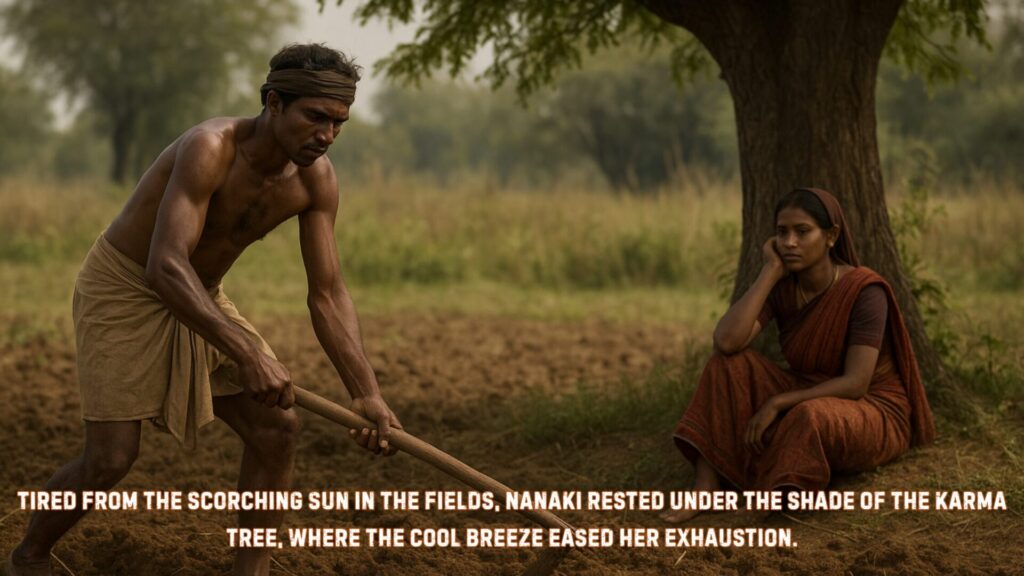
He said that if they served him, they would have children. When Nanaki woke up, she told Birsa about her dream. They both believed it and decided to do as Karamdev said. They cut a branch from the karam tree and took it to their village, promising to serve the god. One year later, their wish came true, and they had their first child. They named him Karma. Soon after, they had another child, whom they named Dharma.
The Tale of the Seven Brothers and the Karam Tree
Karma and Dharma are important concepts that are often mentioned together. They are like the first two sons in a larger family. Over time, this family grows to include seven brothers and one sister, each with a different name. However, the main focus is on Karma and Dharma. Karma is essential for the family’s happiness, and because of this, the whole family enjoys a joyful life.
The Legend of Karma and Dharma
As their family grows, so does their need for money for food and drink. The older brother, Karma, goes abroad with his half-brothers to earn money. After many years of hard work, he hopes to return to a warm welcome from his family. He comes back on Bhado Ekadashi, but instead of greeting him, everyone in the village is busy celebrating and serving Karamdev.
Feeling forgotten and angry, Karma throws the Karam branch into the river. In the following days, the family faces food shortages and famine, which troubles the whole village. They soon realize that their suffering is due to Karma’s actions. To fix his mistake, Karma sets out to find the branch. During his journey, he feels thirsty but finds worms in the water. He is also unable to eat food, as he finds worms in it too.
Later, he discovers a crocodile trapped in a net. After helping the crocodile escape, the crocodile helps Karma cross the river. Finally, Karma retrieves the Karam branch and brings it back home.
When is Karma Festival Celebrated?
Karma Utsav is a lively festival celebrated every year in Bhadrapad or Ashwin, which is around August and September. This festival marks the end of the monsoon season and the start of the harvest. People celebrate it on the 11th day (Ekadashi) of the waning moon in the Hindu lunar calendar, which is significant for tribal communities.
Different tribal groups in Jharkhand, Bihar, Chhattisgarh, Odisha, Madhya Pradesh, and West Bengal have their own calendars, but many of them celebrate Karma Utsav on the same day. In 2025, Karma Utsav took place on September 3rd (Wednesday). On this day, tribal families gather around the sacred Karma tree to worship the Karma deity. This deity represents prosperity, fertility, and crop protection. Families perform traditional songs and dances as a way to honor the deity and express their wishes for a bountiful harvest.
Rituals and Traditions of Karma Puja
Karma Festival is a lively celebration of tribal devotion that connects the community to nature, agriculture, and their traditions. It is also known as the festival of brother-sister love. This festival highlights unique customs and the community’s bond with nature. Each ritual shows gratitude to Karam Devta, the guardian of crops, fertility, and prosperity. People celebrate Karma Festival with folk songs, dances, fasting, and offerings, emphasising harmony between humans, nature, and divine forces.
Bringing the Sacred Karam Branch
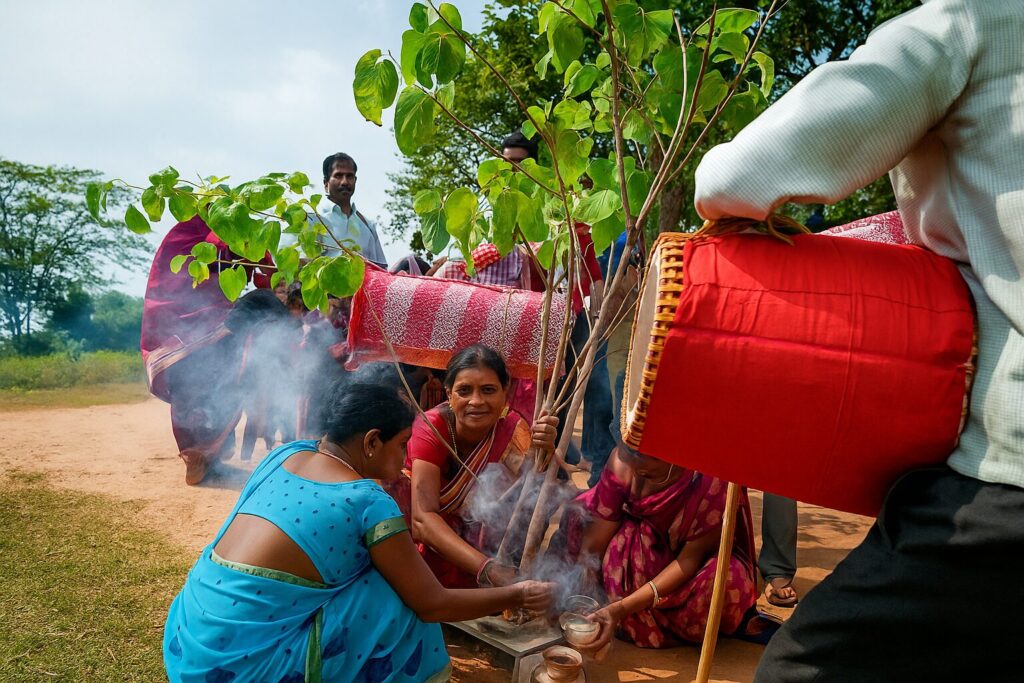
One of the key rituals of Karma Puja starts with collecting a branch from the sacred Karam tree in the forest. Groups of young people from the village go into the forest to select a fresh branch (noclea/kadamba) from the Karam tree. After choosing the branch, they worship the tree and ask for its permission for the ritual.
This ceremony is a way to show respect for nature, as the branch represents the Karam deity, who symbolises youth, strength, and prosperity. The chosen branch is brought back to the village with a lively group dance, along with songs, clapping, and music that express their joy.
They place the branch in the centre of the village or courtyard, known as the wada, and decorate it with vermilion, rice, flowers, and sometimes colourful threads. The women of the community welcome the branch with traditional songs, while the elders sprinkle water around it to purify and bless it. This ceremony reflects the connection between the forest and village life. It reminds the community that true prosperity comes when they respect the trees, soil, and environment that sustain them. The ritual teaches them to honour and be thankful for nature’s laws.
Offerings and Ritual Worship
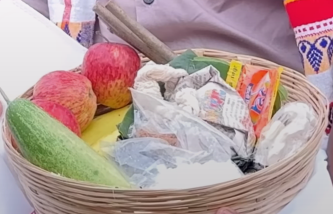
When the sacred Karam branch is placed in the center of the courtyard or village square, the main ritual of Karma Puja begins. This ritual honors the Karam deity to show gratitude. People decorate the branch with vermilion, turmeric, rice, flowers, and thread, making it a symbol of divine presence. Women, especially young girls, gather around the branch with earthenware pots and lamps, while men play drums and flutes to create a holy atmosphere.
When the sacred Karam branch is placed in the center of the courtyard or village square, the main ritual of Karma Puja starts. This ritual is done to thank the Karam deity. People decorate the branch with vermilion, turmeric, rice, flowers, and thread to show its divine presence. Young girls and women gather around the branch with earthen pots and lamps. Men play drums and flutes to create a sacred atmosphere.
Sowing of the Five Grains (Panch Anaj Ritual)
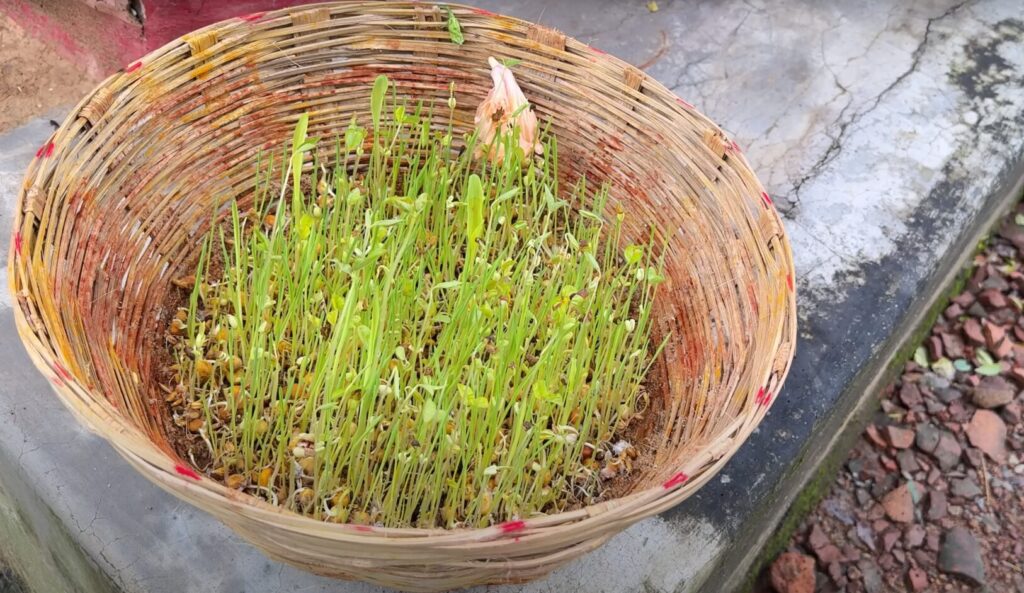
The Karma festival includes a special tradition called the planting of five grains, known as the Panch Anaj Vidhi. A few days before the festival, women and girls in the community fill small bamboo baskets with soil. They plant five types of seeds in this soil: barley, wheat, rice, tur (arhar), and gram (channa). They water and care for these seeds until they sprout, which represents fertility, prosperity, and the cycle of life. On the day of Karma Puja, people bring the sprouted grains, called jawara or ankur, to the Karam branch.
During the rituals, women offer these green sprouts to the Karam deity. The colour green symbolises nature and positivity. They pray for a good harvest, the safety of their families, and the health of their community. In some traditions, people hide the sprouts behind their ears or wear them while dancing to show a blessing from the deity.
The five grains are more than just food; they also have deep meanings. Each grain stands for an important part of life: food, health, fertility, and prosperity. By planting and offering these grains, tribal communities strengthen their connection to the land and recognise their reliance on nature’s gifts.
Songs, Dance, and Community Celebrations of Karma Festival
The Karma festival is energized by vibrant folk songs, group dances, and community gatherings, in addition to rituals and offerings. These cultural expressions serve not only as entertainment but also as a means for tribal people to pass down their values, stories, and sense of unity from one generation to the next.
Traditional Karma Dance
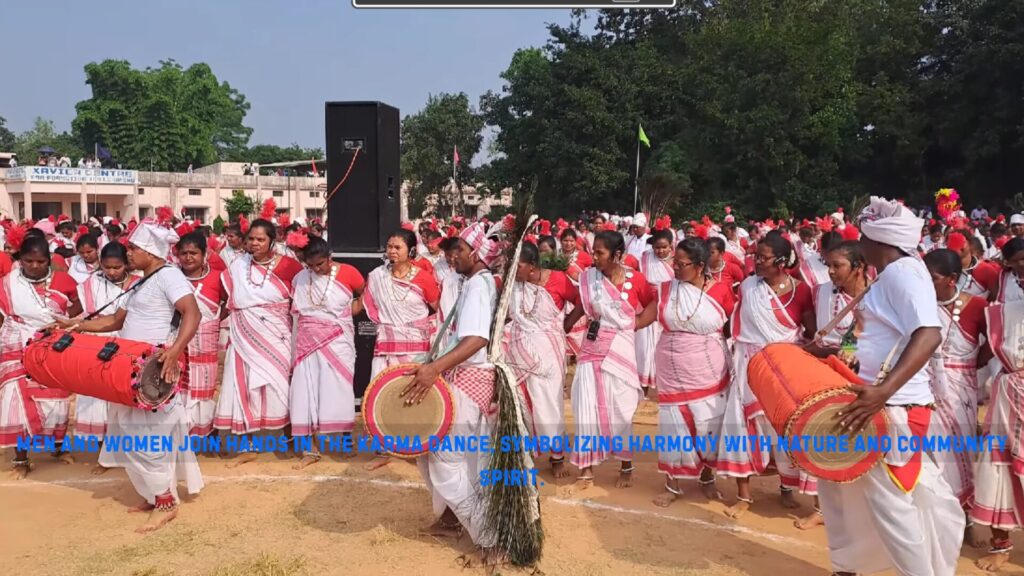
The Karma Samuhik Dance is the main event of this festival. It takes place in circles under the moon around the sacred Karam branch. Men and women, dressed in colorful traditional costumes, hold hands and move in time to the drums and flutes. This dance shows harmony, equality, and the strong connection among community members. Each step and movement is an offering to the Karam deity, who brings blessings of fertility and prosperity.
Folk Songs and Drumming Rituals
No festival is complete without tribal folk songs because music is central to the celebration. Tribal youth sing songs that tell stories of love, bravery, nature, and the blessings of the deity Karam. The steady beat of the mandar (drum), thali (metal plate), and flute creates a lively atmosphere filled with positive energy and devotion. These songs are often sung in local tribal languages and help preserve oral traditions that have been passed down for centuries. They will continue to thrive even in the modern world.
Community Feasts and Social Bonding
After the rituals and dances of the Karma Festival, the tribal community gathers for a large meal. They share locally brewed mahua liquor, rice beer, seasonal fruits, and home-cooked dishes. This communal feast reflects equality and strengthens relationships within the village. It is a moment of joy and togetherness where people celebrate their cultural identity. Young men and women often use this time to socialise, and in many places, the festival also becomes an occasion that strengthens marriage bonds and family ties.
Significance of Karma Festival in Tribal Life
Karma Utsav is an important festival for many tribal communities in India. It is based on nature worship, farming, and oral traditions. The festival represents unity and the love between brothers and sisters. Karma Utsav shows the values, beliefs, and lifestyle of tribes like the Oraons, Mundas, Baigas, and Bhils. It is both a cultural celebration and a spiritual journey that connects people to their land, ancestors, and gods.
Symbol of Fertility and Prosperity
At its core, the festival symbolizes the cycle of fertility and growth. The sowing of five grains represents the five elements. The rituals of worshipping a branch of the tree and offering the harvest reflect the community’s hope for good rainfall, abundant crops, and overall prosperity. For tribal farmers, this festival serves as a way to express gratitude to nature and to renew their connection with the soil that sustains them. Ultimately, the festival is celebrated primarily to reconnect with nature.
Strengthening Community Bonds
In tribal societies, festivals are important community events that promote unity. Karma Puja is one such karma festival that gathers people of all ages. During this celebration, everyone joins in rituals, songs, and dances, creating a sense of togetherness. Sharing food and drinks highlights the values of equality and brotherhood. For young people, the festival also offers a chance to socialise, make friends, and form marriage alliances, which strengthen tribal bonds.
Preserving Tribal Identity and Heritage
The Karma festival is an important event that shows the strength and pride of tribal culture. It features folk songs, traditional dances, and oral legends that share old wisdom and stories about karma (action) and dharma (duty). These stories teach valuable lessons to society. By holding the festival each year, tribal communities pass down their traditions to the next generation, keeping their culture alive. This celebration helps ensure that their heritage is cherished and preserved.
Who Can Celebrate Karma Festival and What Precautions Should Be Taken?
The Karma festival is an important celebration for tribal communities like the Oraon, Munda, Baiga, Bhil, Gond, and Santhal. It promotes harmony with nature and respect for cultural heritage, values appreciated by everyone. Traditionally, it is celebrated in Jharkhand, Chhattisgarh, Odisha, Bihar, Madhya Pradesh, and Gujarat. Anyone can join the celebrations, and many non-tribals participate to honour its environmental and cultural focus.
karma festival is for unmarried tribal girls, young men, and women. It lasts for seven days, reflecting the seven siblings involved in the tradition. Participants must not eat meat during the festival. Married women who wish to have children can fast and celebrate for their child. A special dish called “cucumber” is made and offered to the elders as prasad. This dish represents a beloved child for those who are fasting.
FAQ
What is the Karma Festival?
Karma Festival is a tribal celebration dedicated to Karam, the god of youth, fertility, and prosperity. It symbolises the selfless spirit of brother-sister and includes religious rituals, the sowing of five grains, traditional dances, and communal celebrations.
Which tribes celebrate the Karma Festival?
It is mainly celebrated by tribal communities such as the Oraon, Munda, Gond, Bhil, Baiga, and Santhal, across states like Jharkhand, Chhattisgarh, Odisha, Bihar, Madhya Pradesh, and Gujarat.
When is Karma Festival celebrated in 2025?
In 2025, the Karma Festival will be celebrated on 3th September (Wendsday). The date usually falls in the Hindu month of Bhadrapada, during the monsoon season.
What is the significance of sowing five grains during Karma Puja?
The Panch Anaj ritual (sowing of five grains) symbolises fertility, prosperity, and renewal of life. The sprouted grains are later offered to Karam Devta as a sign of gratitude for good harvests.
Can non-tribal people celebrate the Karma Festival?
Yes, anyone can respectfully participate in the Karma Festival. However, it is important to honor the rituals, respect the sacred Karam branch, and treat the event as a cultural-spiritual occasion, not just entertainment.
Conclusion
The Karma Festival is a celebration that connects tribal communities to nature and their traditions. It involves worshipping the sacred Karma branch, planting five grains, singing folk songs, and dancing together. The festival celebrates life, fertility, and unity. It teaches the importance of karma (duty) and dharma (righteousness), showing that true happiness comes from living in harmony with nature and respecting cultural roots. The festival remains important even in today’s modern world. It reminds us that traditions are valuable and relevant for the future.
For tribal people, this festival is a proud expression of their identity, while for others, it offers a chance to learn how to live more closely with the land. The Karma Festival reminds us that real wealth is not about material possessions. Instead, it comes from strong community bonds, respect for the earth, and the life lessons passed down through generations.
Your feedback means a lot to us.
If you have any questions, suggestions, or concerns feel free to leave a comment below.We’re here to listen, grow, and improve together.
